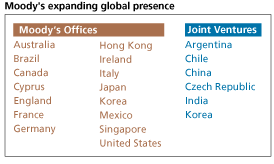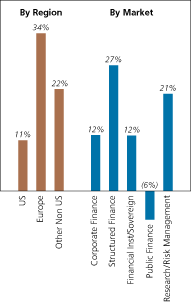| Our Environment Growth in worldwide capital markets As Moody’s enters a second century of growth, powerful forces continue to drive the expansion of the world’s capital markets and thus demand for the objective, reliable credit risk opinions that have been our stock-in-trade for 100 years. Today, capital markets worldwide account for over $40 trillion of debt issued by governments, corporations, financial institutions, and other borrowers. These borrowers increasingly seek capital in the public bond market, rather than relying on funding from banks and other financial intermediaries. Moreover, financial institutions are securitizing assets to improve return on assets and return on equity, as well as to more efficiently manage regulatory capital. These trends – coupled with a worldwide shift toward deregulation and open markets – are fueling growth in both the volume and complexity of fixed-income securities. As capital markets expand worldwide, Moody’s presence becomes ever more global.
At the same time, advances in information technology – from the telephone to the desk-top PC to the Internet – facilitate the speed and volume of financial transactions by bringing together borrowers and lenders who reside on different continents, speak different languages, and live in markedly different cultures. In this context, there is a clear need for a common, easily understood means of comparing the risks of a growing number of investment opportunities. In addition, a robust and sustained global economic environment fuels yet more demand for financing the growth prospects of corporations and governments worldwide. The European Monetary Union provides a clear illustration of the impact of these trends on Moody’s business environment. By eliminating foreign exchange risk among member countries, the union facilitates cross-border borrowing and investment. It also propels Europe into the first rank of financial markets and creates immediate, broad-based need for credit ratings that help borrowers access a deeper funding base and assist investors in the evaluation of their exposures. Borrowers, eager to finance their growth from new sources, see benefits in diversifying their funding base. But their lack of recognition in these new markets presents the need for an efficient mechanism through which their business prospects and financial capacity can be communicated. Investors, as the providers of capital, face a greatly expanded range of investment options. This expansion provides diversification opportunities that bring the potential for higher returns. But the proliferation of complex investment alternatives requires that investors more carefully weigh risks and rewards. As a result, there is rapidly growing demand for Moody’s services among borrowers and investors alike. Particularly in regions where capital markets are expanding swiftly, like Europe, and in sectors characterized by capital market innovation, such as structured finance, Moody’s global reach and broad scope bring considerable value to these customers. As a consequence, since 1996 Moody’s revenue growth has been driven by high double-digit increases outside the US and in the global securitization market. Disintermediation, information technology, deregulation, and securitization are powerful forces on capital market development and are expected to persist in the decades ahead. In this environment, Moody’s is prepared for a second century of growth in its increasingly diverse, and consistently successful business.
|

